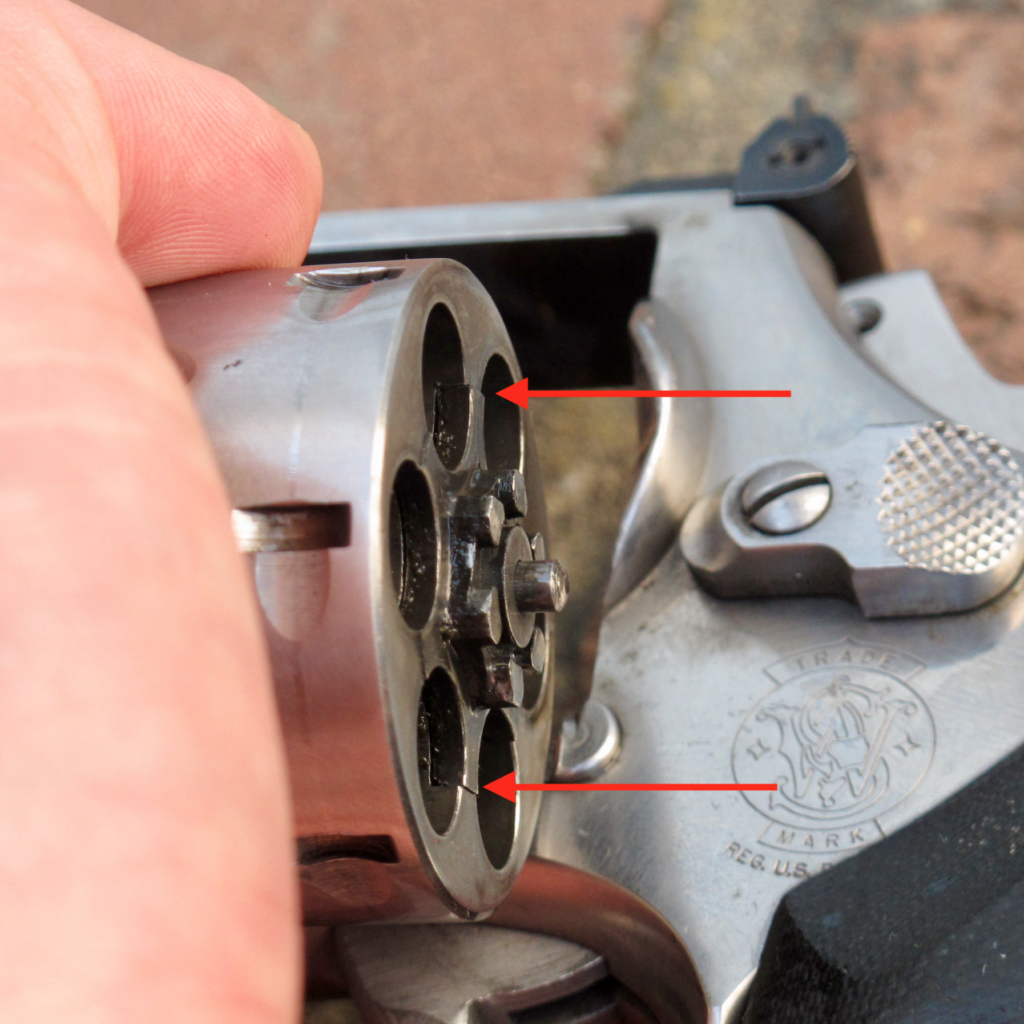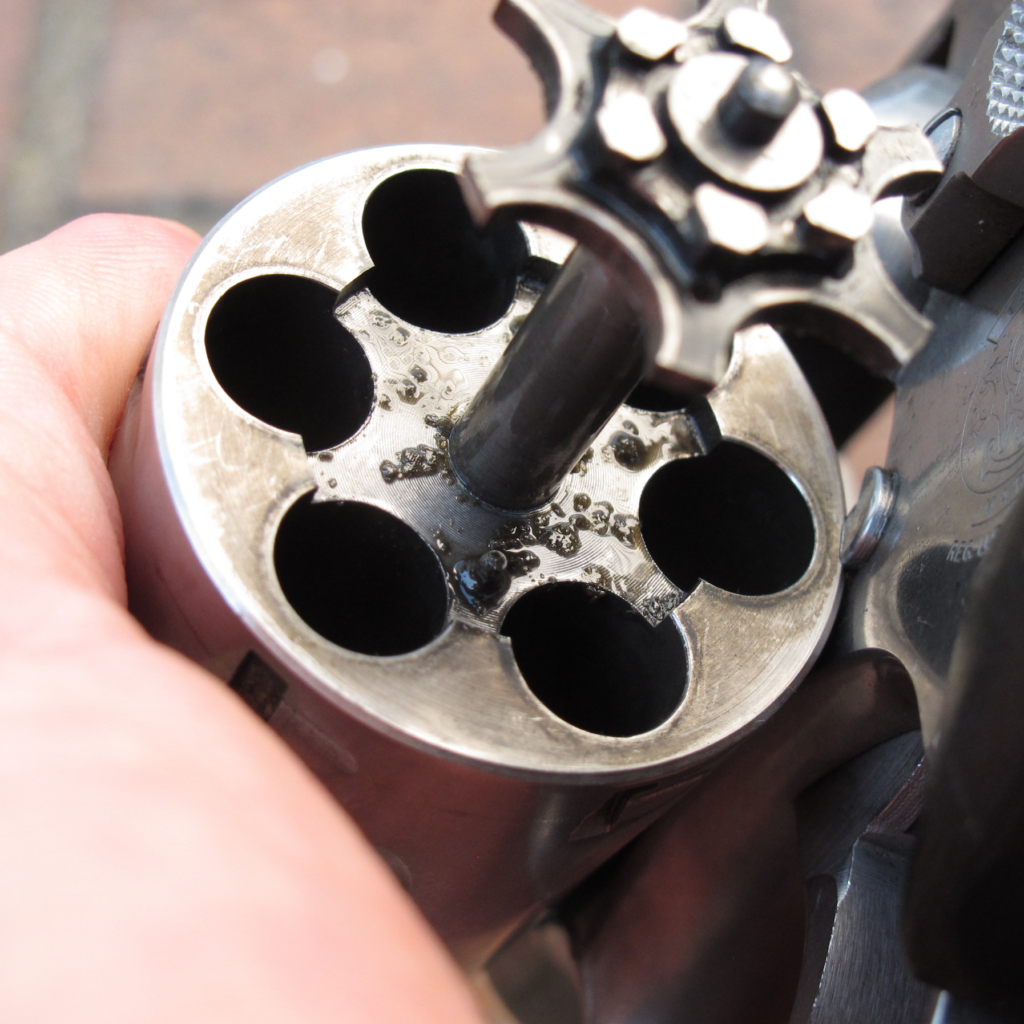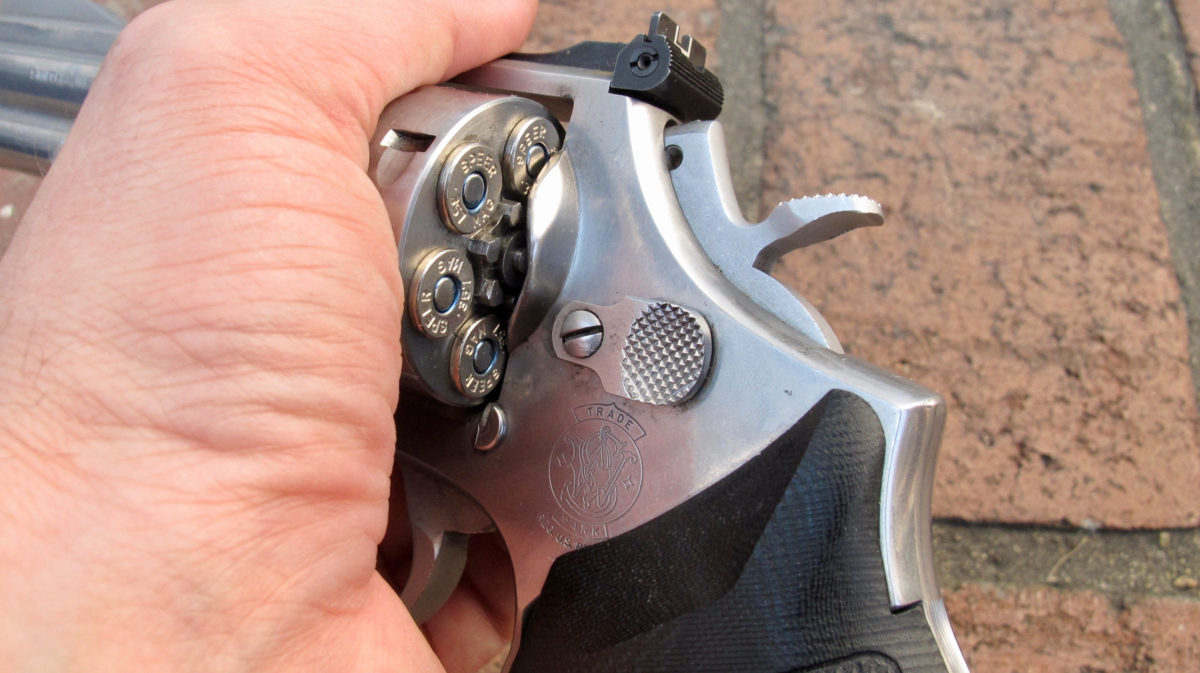I recently had one of the more obscure revolver malfunctions: the under-the-extractor-star malfunction. It didn’t happen anywhere bad. It wasn’t during a competition, it certainly wasn’t in a gunfight, and it didn’t even inconvenience one of my range sessions. It happened while I was cleaning the grit and gunk from the darling of my collection, my 686-3.
the Under-The-Extractor-Star Malfunction
True to its name, this malfunction occurs when particulate matter accumulates under the extractor star. The accumulation of matter becomes so great that the star cannot fully seat. When the star can’t seat, the cylinder won’t close. At best this can slow down your range session; at worst this can prevent you from reloading in-extremis. The debris under the star doesn’t have to lift it very much. Quality revolvers are finely-tuned instruments. Even a few thousandths of an inch is enough to prevent the cylinder from closing.

The under-the-extractor-star malfunction is immediately recognizable. Your cylinder will not fully close, or is very hard to close. Under non-life-and-death circumstances I caution against attempting to force your cylinder closed. Close inspection will reveal that the extractor star is just ever so slightly out of battery, as illustrated above.
Clearing the Under-The-Extractor-Star Malfunction
Unfortunately, I don’t have any great news here. The biggest problem with this malfunction is that occurs mid-reload. This assumes that you have been in a fight and have expended all your ammunition without having successfully resolved the situation. By the time you notice the under-the-extractor-star malfunction you have already loaded cartridges into the revolver from your speedloader or Speed Strip. Let’s look at two potential courses of action for this malfunction, both of which are far from ideal.
Clean it out: The most obvious course of action is to clean out the junk under the star. This creates a big problem – the ammunition in the cylinder. To clean the offending debris from the gun requires getting the ammo out of the cylinder. You may be able to clear the mess by blowing and/or wiping with your fingertip, but you still find yourself in the unenviable position of holding loose rounds and an unloaded revolver. Obviously if you are not threatened with imminent death, this is the preferred technique.
Make it work: This is probably what I would be most inclined to do under a real-life threat: slam, bang, slap, and kick the cylinder until it went into battery. Be warned: there are a couple of MAJOR downsides to this technique! First, you may damage the ejector rod, crane, or other parts of your revolver, completely dead-lining it. You also risk getting the cylinder stuck half-closed with an identical end-result: your revolver is inoperable.
Preventing the Under-The-Extractor-Star Malfunction
Because this malfunction is such a devil to deal with, the primary antidotes are preventative in nature.
Keep your revolver clean. The most important step you can take to prevent the under-the-extractor star malfunction is to keep your revolver free from debris that can fall under the star. When you invert the revolver to eject empties, this matter can free itself, and fall onto the extractor star. Because most of the matter than would lift the star sufficiently to cause a malfunction is (relatively) large, this is as simple as brushing your revolver free of any unburned powder, dirt, and other detritus after each range session
Use lubricants sparingly. The cause of my under-the-extractor-star malfunction was drowning with lube while cleaning. Too much oil will do two things. First, it will allow dirt and debris to stick much more readily, and cause an unacceptable level of accumulation. Secondly, it can cause dirt and debris to “bunch up” into a large, malfunction-inducing mass. You should clean your revolver, but ensure that excess lube or solvent doesn’t accumulate under the extractor star. Fortunately, because most carry revolvers are carried muzzle-down, excess lubricant tends to flow away from the extractor star rather than toward it. Still, I like to err on the side of keeping this area pretty dry.

Use clean ammunition. I place this step last because I think it is the one of least concern. I have shot ammunition in my revolvers ranging from boutique, high-end stuff, to bottom-of-the-barrel reloads and re-manufactured ammo with no ill effect. However, if your chosen defensive ammunition produces a surfeit of unburned powder residue, you may want to reconsider carrying it. If your range ammunition is excessively dirty keep shooting it, but adhere closely to steps 1 and 2 above.
The Bottom Line
Revolvers aren’t magic and contrary to popular belief, they DO malfunction and “pulling the trigger again” doesn’t resolve all of them. The under-the-extractor-star malfunction is not one you want to experience in a self-defense situation. Fortunately for us, occurrences of this malfunction are relatively rare and are easily prevented. Keep your revolver clean, use high-quality ammunition, and inspect your equipment regularly.


Good advice for those who think that “revolvers never fail.” Never had it with factory ammo but with .357 reloads only. Never had it yet with .38s I load with Bullseye, a fast-burning powder. I keep an old toothbrush now in my range bag.
For my carry gun it always starts clean and loads only factory.
No time to pull out a toothbrush in a self-defense setting. I suppose my foe might double over laughing, once he saw the toothbrush.
I bring three .22 revolvers to our local 4H handgun shooting classes. By the end of 2-3 hours, the electors begin to exhibit this problem.
Before I started using the dry lube EEZOX, this problem was quite common. Now it only seems to happen after 400+ rounds.
I carry canned air in my range bag when shooting revolvers…partially lift the star and give it a blast.
I have not seen this yet, but I have had a piece of spent brass hang up under the star. I guess I didn’t hit the extractor vigorously enough. I know I would hate that to happen in a gunfight!
Riley,
I’ll take this moment to differentiate those two types of malfunctions. Brass under the star is a little different, and this weekend at Haggard’s Practical Revolvers I learned a little trick that might help you with those. More to follow…
Justin
I had this same problem with a particular S&W Model 10. I found that a deep speedloader relief on my beautiful new wood grips would contact one shell rim and cause it to bounce out of engagement with the extractor star. Then once I’d break contact with the ejector rod the star would pull that one piece of brass back up into the cylinder under the star!
I enjoy everything you guys write, but these kinds of articles tend to be my favorite. I feel like I come away with some practical knowledge I can immediately apply to my newfound love of revolvers.
Good advice about keeping things dry under the extractor star. One other tip I’d add: hold the muzzle up vertically when ejecting the spent brass. It won’t prevent everything but makes it far less likely that unburned powder will fall back under the star.
Hmmm……where have I heard this before?
https://revolverguy.com/rg101-stressfire-revolver-reload/
; ^ )
Thanks for the article–revolvers absolutely do fail, but I think it’s more commonly user-induced (lack of cleaning/maintenance/proper technique). I’ve put lots of rounds through 6 different revolvers since I began shooting. The only problems I’ve had have been 1) empty brass caught under the ejector star due to bad speed reloading technique and 2) misfires with my S&W 66-2 due to the previous owner putting in a too-light mainspring (happened with several different types of ammo so I knew it was the gun).
Best,
Paul
I should be so lucky! Also, “reliable with maintenance” and “reliable” aren’t quite the same thing. For those of us that shoot thousands of rounds per year, I classify revolvers and 1911s as “reliable with maintenance,” aka enthusiasts’ guns. On the other hand, modern striker guns are just “reliable,” going thousands of rounds between cleanings, tightening this, or checking that. Which is kind of the point of these malfunction articles. If you shoot your revolvers enough, they will malfunction.
A classic design, such as the Python, Trooper, S&W M19, 27, 29 . . . any of them with a cylinder for a magazine, is going to be like the venerable North American P51D Mustang fighter of WWII vintage. They’re still flying, they fly well, but they require ‘special attention’. The 12 cylinder Merlin 1600 has a beautiful sound that is unique to the Mustang. BUT . . . the Merlin was designed for wartime use where engine life was all too often measured in tens of hours. Nursing a Merlin to 200 hours takes a lot of gentle care and attention.
The Glock, on the other hand, is sort of like the good ole’ Boeing 737 (Boeing’s best passenger jet ever IMHO) Unlike the pistons, connecting rods, valves, cams and everything shaking the engine apart, the gas turbines on the Boeing spin smoothly in sync and have a nice harmonic hum to them. Plus, the pair of CFM-56s slung under the wings will keep going and going until it’s time to ‘change the oil’ (every 4,000,000 miles)
I couldn’t have said it better myself! I’m a tinkerer, so I’m a wheelgun and (especially) a M1911 addict!
You Sir, have the heart and soul of a pilot!
Indeed, there’s no sound like a Mustang, with its beautiful and throaty Merlin, roaring overhead!!! One wonders whether some hapless German soldiers spent their last moments standing in stunned awe of that auditory and visual spectacle swooping down upon them from the heavens . . .
The B737 doesn’t have the sex appeal of the B757, so your Glock analogy is PERFECT. She’s a dependable workhorse, but no beauty queen!
I guess being the spawn of two lifelong pilots had something to do with that. What is ironic about the Rolls-Royce Merlin 66 and its counterpart, the Packard V-1650-7, is that it sounds different in a P51D airframe than in a Spit or Lancaster. Perhaps its how the airflow goes over the exhaust, or perhaps the massive screw up front affects it. What ever it is, the Mustang has her own unique sound, much like the UH-1H.
I tend to think most hapless Wehrmacht soldaten were scrambling for cover when the Mustangs (and Spitfires, Typhoons, Thunderbolts, etc) came screaming down.
The 757 reminds me of the centerfold type model. Has sleek lines, looks lean, mean and agile, but high maintenance. The 757 is perhaps Boeing’s ‘sexiest’ commercial jet. But for the ‘girl next door’ that’ll always be there, and would be the keeper – that has to go to the 737 or BBJ (Boeing Business Jet, a/k/a 737) any day.
B757: Long legs, big . . . um, engines. Sexiest of the transport-category jets!
The B737 is a keeper for sure. You described them perfectly!
The Merlin sounds different in a Spit because the Brits wouldn’t have found it proper to make too much noise. ; ^ )
Agree with all this–also before the 1990s, when revolvers were the sidearm of choice, I think people tended to shoot a lot less. I gather it was pretty rare to go through hundreds of rounds in one session. Now that is routinely done with Glocks, H&Ks, etc. I have attended a course where we went though almost 2000 rounds in one weekend. I’m not sure revolvers were really designed for that kind of shooting.
Best,
Paul
Good advice for any revolver lover…and something us “old revolver Guys” learned many years ago. THBS I had a unique (for me) incident at the range with my (also) favorite 686-2…A micro-thin ring of brass was left on the underside of the rim of a factory 38spl round during manufacture, about the thickness of a coarse human hair….preventing the round from seating fully…took a few minutes and the removal of my glasses
( so I could see)…ha….to locate the little sucker, which I managed to stretch until it broke off the rim…allowing the round to seat
Been shooting revolvers since 1968…carried one on-duty for 15 yrs…never seen this particular malfunction before…never too old to learn something new
Unburned powder is a problem. I would have placed it at number 1. I had a load of Green Dot that was accurate and low recoil, used it for IDPA in my 586-0. A couple times a few flakes got under the extractor. It can cause a total stoppage or it can close and be so tight it won’t work. I switched to WST and haven’t had a problem with it. I do wipe under the star with my finger, run a bristle brush thru the cylinder during a match. I pays to keep a revolver clean.
It will help if you keep the cylinder vertical when ejecting empties. Unburned powder then tends to stay in the case. I used to hold cylinder horizontal, and with large quantities of 2400 in my Model 29 it was not long before I could not close the cylinder. Thought my gun was “broke “ before I noticed all the unburned powder under the ejector star.
Excellent article! I had it happen to me in the middle of an IPSC match. I hadn’t cleaned well enough! Live and Learn! It only happened once.
Happened to my 686+ on the fourth stage of the ‘10 Missouri monster match, after my first reload. Thought my day was over, and the gun was headed to the smithy. But after a few minutes of wiggling and jiggling things back in the safety area, I apparently cleared the cinders, because it started working again and finish the match cleanly. Never actually saw the crud under the star, but that must have been what it was.